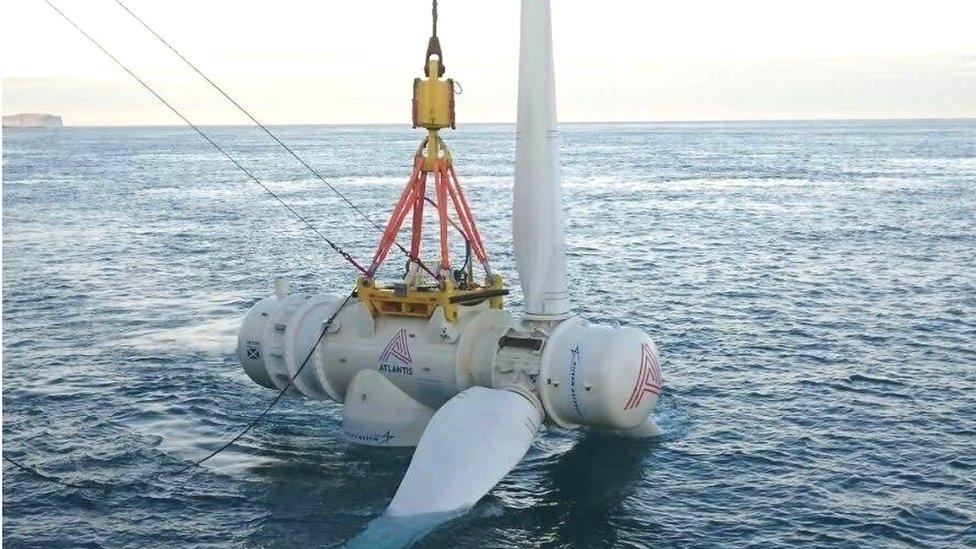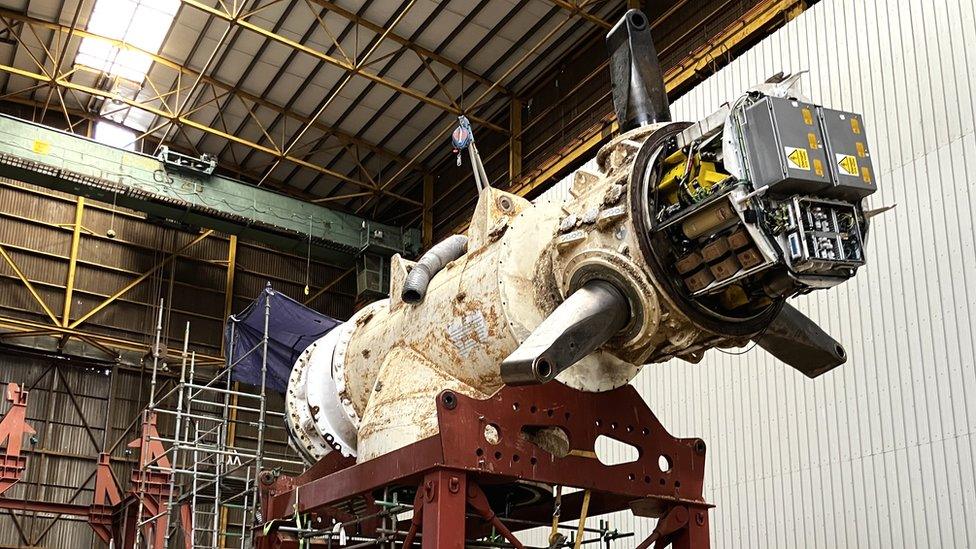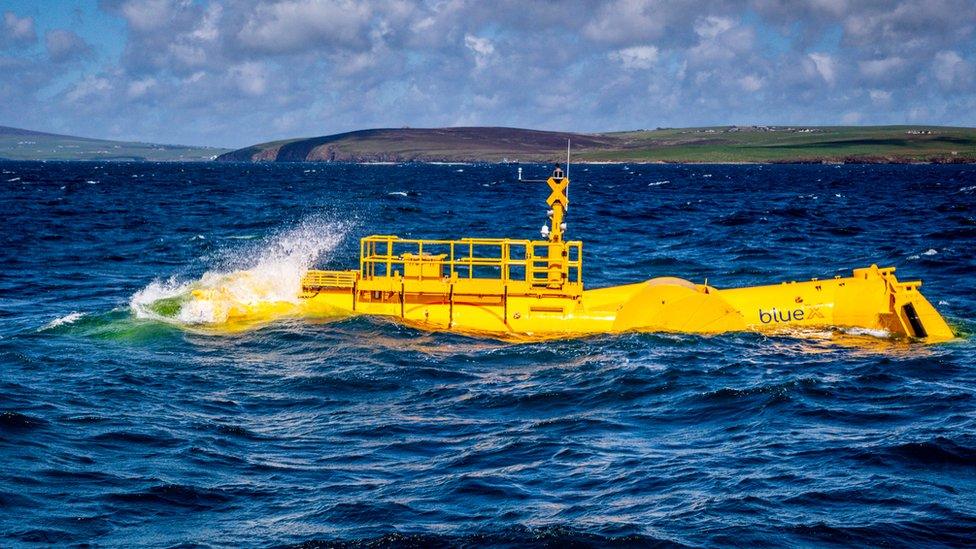Why Orkney's wild seas host advanced energy projects
- Published

MeyGen plans to install 22 turbines on the seabed
In a vast, rust-stained hangar on a windswept quayside an hour's drive from Inverness, sits a piece of state of the art technology. It is covered in barnacles, and smells overpoweringly of fish.
The machine is a tidal turbine, one of four that normally stand on the seabed beneath the frigid waters of the Pentland Firth, the strait that lies between the far north of mainland Scotland and the Orkney Islands.
Brought in for servicing, its 150-tonne bulk is supported in a giant metal cradle, and its complex wiring is exposed. Its 8m long blades, which look similar to the ones you would find on a wind turbine, have been laid out carefully on the floor.
When running it is capable of producing a peak output of 1.5 megawatts (MW), about half the output of the average offshore wind turbine.
The MeyGen project, as it is known, has been operating in the Pentland Firth since 2018. The four turbines are based in the strait's Inner Sound, just off the island of Stroma.
It is a stretch of water known for having some of the fastest tides in the world, making it a particularly good location for honing tidal technology.
Although tides themselves are usefully predictable, the marine environment is a very harsh and corrosive one that can take a heavy toll on machinery - which then needs to be taken out of the water for repair.
The current array has been set up as a demonstration project - to show that the equipment can be deployed effectively. So far, it has successfully generated more than 50 gigawatt hours of electricity in its lifetime, becoming the first tidal turbine scheme in the world to do so.
The next stage of the scheme will be rather more ambitious. MeyGen's owner SAE Renewables wants to install another 17 turbines, each larger than the existing models and each capable of generating up to 3MW, to create a 50MW array.

Servicing the turbine involves removing the blades and a strong smell of fish
The company already has contracts to sell the electricity it generates into the national grid. But the nature of those contracts highlights the biggest current downside of tidal power: It is still very, very expensive.
Under a scheme used by the government to promote renewable energy, providers are guaranteed a price for the electricity they produce - even if the actual cost of power on wholesale markets is much lower. A government subsidy makes up the difference.
MeyGen will earn up to £198 per MW hour of electricity produced for the next 15 years. That is nearly four times what providers of onshore wind and solar power will be paid under equivalent contracts granted at the same time.
"It is a problem," admits Fraser Johnson, O&M Manager at MeyGen.
He agrees that costs have to come down dramatically if the sector is ever to become truly commercially viable. But he believes this can ultimately be achieved by increasing capacity.
"It's really increasing the scale, increasing the number of units to drive down cost. We need to make the power cheaper, make the installations cheaper and overall get the price down for the consumer," he says.


A study published last year, external, commissioned by the Offshore Renewable Energy Catapult, and carried out by Imperial College London, does support this idea.
It suggests that a steady expansion and development of tidal power could bring production costs down to around a quarter of current levels by 2050. This would make it sufficiently competitive to replace a significant quantity of gas generation.
A few miles away, in the turbulent waters to the east of the Orkney Islands, efforts are being made to harness a different form of marine energy.

Blue X generates electricity from wave power
Lurking on the surface is a giant yellow machine, hinged in the middle and with large claw-like structures at each end, looking for all the world like a kind of mechanical sea monster.
This is the Blue X developed by Edinburgh-based engineering firm Mocean Energy. It has been designed to harness wave power - which can then be stored in underwater batteries.
It is the latest in a series of wave energy converters which have been trialled around the UK - many of them off Orkney. But getting beyond the prototype stage has proved difficult.
"People have been trying to develop wave energy machines for a long time now. What they haven't been able to do, is do it economically," explains Mocean's managing director, Cameron McNatt.
"What we're doing is starting small, in markets where we can be cost competitive straight away."
This means using wave machines initially to power off-grid equipment used by offshore industries, or to provide energy for isolated island communities, rather than trying to sell electricity to the grid.
But in the longer term, the company wants to see the technology used much more widely, with tens or even hundreds of machines deployed in offshore farms.
"That's absolutely the dream," says Mr McNatt.
"And these farms could be combined with offshore wind. So we can deploy devices in the offshore wind farms, maximising the utility of that space."

The waters around Orkney have become a centre for developing tidal and wave power
Over the past two decades, the waters around Orkney have become something of a laboratory for developing wave and tidal technology.
In part, that is down to simple geography and weather, which creates waves of up to 18m in height, along with those ripping tides.
But it is a trend which has been encouraged over the past two decades by the European Marine Energy Centre (EMEC), a not-for-profit organisation, based in Orkney, that has created purpose-built testing facilities around the islands.
These include subsea cables, data monitoring systems and an onshore substation, which allow developers to plug their prototypes into the grid and assess their performance at minimal cost.
"By demonstrating something here, you're reducing the risk for investors further down the line", explains EMEC's Eileen Linklater.
"We're very good at coming up with inventions - but we also have to think about how you make that invention a real part of the energy system".